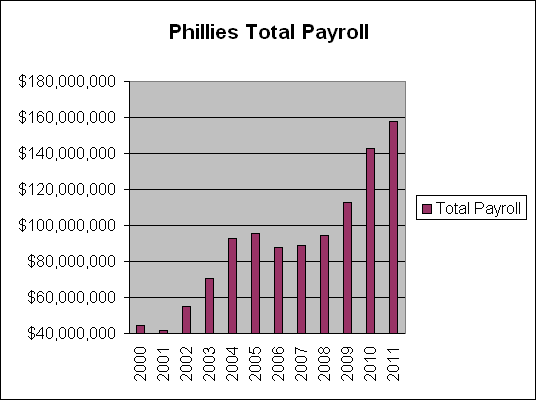
Now that the Phillies have blown up their payroll by adding Cliff Lee, the total payroll looks to be over $160 million in 2011. Once regarded as greedy Gremlins who lurked in dark alleys, all of a sudden this Phillies ownership group is “committed to winning.” But just how committed are they?
I thought it might be fun to watch the progression of the Phillies payroll in recent years. The chart above shows the progression of the total payroll since 2001.
Once referred to by Bill Giles as a “small market” in 1994, the Phillies payroll lived up to Bill’s claim as recently as 2001 with a payroll of just $41.66 million. Ten years later the Phillies total payroll has skyrocketed to around $160 million.
Have the Phillies owners finally decided that winning is more important than making the most profit? The answer is no. As the charts below will indicate, the Phillies owners are no more or less committed in 2011 than they were in 2001.
You see, as much as Phillies fans don’t want to admit it, the owners weren’t paying because the fans weren’t going. Bill Giles was right when he called Philadelphia a small market because at the time fans were not attending games. The next chart shows that the payroll went up at nearly the identical rate of the attendance.
As fans, we want to have an owner like a George Steinbrenner who is willing to pay whatever it takes to put a winner on the field. It sure would have been nice if the Phillies ownership group decided to forgo a little profit during some of the bad years to help build a team that fans wanted to see.
But the next chart shows that the Phillies ran the team no differently than any other club. They ran it like a business and their spending mirrored the attendance. It would have been nice if winning was the most important factor.
The moral of the story is this: the Phillies ownership group was not lining their pockets any more or less than the other owners. I am like many fans who crucified the owners when they weren’t spending the way I hoped they would spend. For better or for worse, the Phillies owners let the books decide how much they would spend and they closely followed the bottom line.
But there might be a wrinkle to this tale. The Phillies maxed out the attendance last season, yet they increased the payroll close to $20 million this year. Are the rumors true that John Middleton took his profits from the $2.9 billion sale of his cigar company and decided to break the bank to get Cliff Lee? Or are they just running business as usual?












